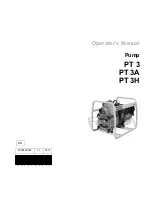
5
Instructions and Maintenance Sheets
Electric Test Pump “HEP0020”
FILLING AND POURING
‐
Verify that the liquid in the tank is compatible with the characteristics of the pump.
‐
Insert the suction and discharge pipes into the container to be filled or poured. High pressure pipe should be
placed in the tank where liquid will be poured or connect to the system to be filled (i.e. solar panels).
‐
Before staring the pump, move the regulating valve (blue) to the 'BYPASS' position, completely open.
MAINTENANCE
‐
To avoid damage to the pump, clean it after its use. For that, run the pump with clean water under pressure for a
few minutes. Then empty the pump and leave it drying for during some minutes.
‐
Avoid frozen water inside the pump, it will damage the pump and the joints. In case of frost hazard, empty
completely the pump from water or mix it with an antifreeze fluid.
‐
Suction valve and gaskets:
Dirty or damaged seals will avoid the valve closing perfectly. Remove the valve cover
and check if the seals are clean.
‐
Membrane replacement:
Remove the head and the membrane. Clean internally with diesel. Carefully assembly a
new membrane. Then, fill the pump with oil and rotate manually the shaft to discharge the air. Check oil level
after this operation. Close the oil tank and check the oil level with the pump pressurized.
‐
Oil change:
First oil change should be done after first 500 working hours, and then every 500 working hours. For
that, remove the oil cap, turn over the pump, and empty all the used oil. Then place the pump in its normal
position and
fill up the oil tank up to the level with SAE 30 oil.
Warning:
A higher oil level will cause high pressures
and tensions inside the pump and can damage the pump head. Then, start the motor and run it for a few minutes
without water. Check the oil level again and refill it if necessary.
‐
Periodically check the condition of the pipes, hose and the filter.
‐
Use original spare parts and accessories. Repair operation must be performed always by qualified personnel.
‐
If the pump is not used for a long time, or in low temperatures countries, pump a little amount of no‐frost
solution into the pump. This will enlarge the life of the gaskets and avoid the freezing. Before re‐starting the
motor, if necessary, turn the valve manually.
TROUBLE SHOOTING
‐
Motor does not start:
Check electrical connections, thermic protection, emergency stop switch and magneto
switch on the machine. Check differential on the power line.
‐
Motor stops suddenly:
Thermic protection switched off the pump for too high temperature. Check if voltage is
correct. Wait 10 minutes to re‐start.
‐
Motor overheating:
Check motor ventilation, starter conditions and oil level.
‐
Pump does not turn:
Check if 'BYPASS' valve is open and check starter capacitor.
‐
Pump does not reach the desired pressure:
check in order: suction filter, air in the pump, pressure valves, inlet
connections, seals.
‐
Pressure change continuously:
check the presence of air bubbles in the circuit, check the presence of dirt, the
filter, valves and seals.
‐
Pressure drop:
Check dirty on filter and valves. Check the gaskets.
‐
Noisy pump:
Check air suctions. Clean and move the valve. Clean the filter. Check water temperature. Check
mechanical parts, particularly ball bearings.
‐
Oil leaks:
replace oil gaskets.
‐
Motor Hum:
Turn off the motor immediately and verify if the pump is not blocked. Check if the voltage in the
electric net corresponds with the data label. Remember that long power cords may cause voltage losses. Verify
voltage at the pump plug.
























